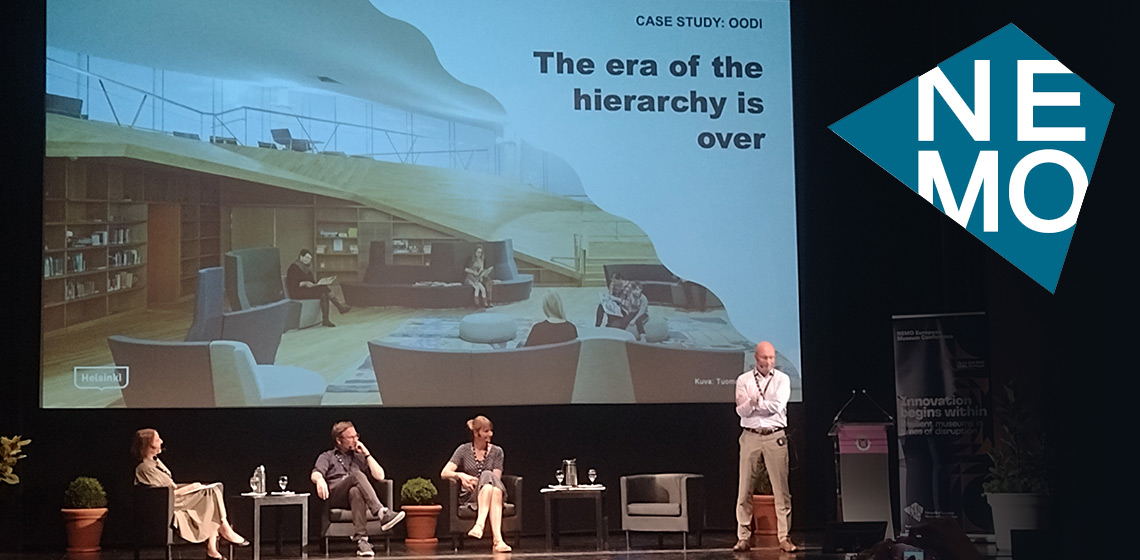The content is published under a Creative Commons Attribution Non-Commercial 4.0 License.
Unreviewed Mixed Matters Article:
Conference Review: Innovation begins within. Resilient museums in times of disruption, NEMO 2022

The Network of European Museum Organisations (NEMO) celebrated their yearly conference in October 2022 in Loulé, Portugal. More than 200 people attended. EXARC is a member of NEMO and we decided to take a look. The format of the conference was not tedious at all, and everything was well organised. This made it easy to take in the information from the presenters.
The keynote by Michael Peter Edson was a friendly reminder to us all about why the world needs to change in order not to end. This is as much in the hands of the museums as in everybody else’s. Innovation, the theme of the conference, is not a goal in itself, a box you can tick off, but a tool. However, when change is required, we tend to only do what is easy instead of what is needed most. We take the safest way, and only make incremental steps which do not bring us where we need to be. However, how can we step out of our comfort zone if we are not comfortable in our job environment? He then discussed the difference between symbolic and impactful outcomes. We can make a large difference if each of us will do one thing extra but taking up one more thing means dropping something else as well because there is no time to do all. What would you be willing to let go?
Many other conference presentations referred to Covid 19 and how this disrupted our life, and very few related to the more recent disruptions caused by the war in Ukraine. The energy crisis and inflation as the silent killer were mentioned, but we have not seen the full impact of the war just yet.
Martin Zierold, HfMT Hamburg, discussed that cultural leadership is not a kind of magic. He sees two core tasks of cultural leadership: on the one hand playing a culture-shaping role for society and on the other hand it is about leading a cultural organisation. These two tasks are not easy to combine.
Caitlin Southwick from Ki Culture gave us a more urgent reminder that museums really need to step up to save the planet. Sustainability is not just that “green paragraph” in your year report, but it has environmental, social, and economic aspects, to name just a few. Southwick gave a lot of practical examples which are easy to implement in most museums. An example is the question as to what history a museum is telling? Is it inclusive towards those people who are part of it? Culture is no longer “leisure” or even neutral, neither are museums. Southwick gave an example of Ecomusée Tata Somba, Benin. It is built by the community for the community. She asked us to how we can stay relevant in the face of all these crises.
Olga Tykhanova, representing Museum Booster mentioned how there have been exponential levels of innovation in the technologies available to the sector, but much less in the processes to which they are applied. People struggle to adapt, and for that reason we should not see museums as machines, but as living systems.
Where many people present their museum as best-case example, in the session “failing upward” several colleagues had the courage to discuss mayor failures, like how (not) to build up marketing skills, walking down the Sustainable Developments Goals (SDG) at a snail’s pace or a festival in a large city: from Panorama to Panodrama. The biggest mistake in most of these examples was internal and external communication, and there is seldom enough trust to discuss failures. This session was extremely useful and would be welcomed as a session in next year’s conference in Finland.
All in all, NEMO seems to be mostly on top of the current issues in the museum world. It is important to work towards the future and feel strengthened by colleagues and by NEMO as an organisation. Of course, there are other organisations as well, for example the International Council of Museums (ICOM), but in a way, Paris is at a larger distance than Berlin…
Keywords
Country
- Portugal

